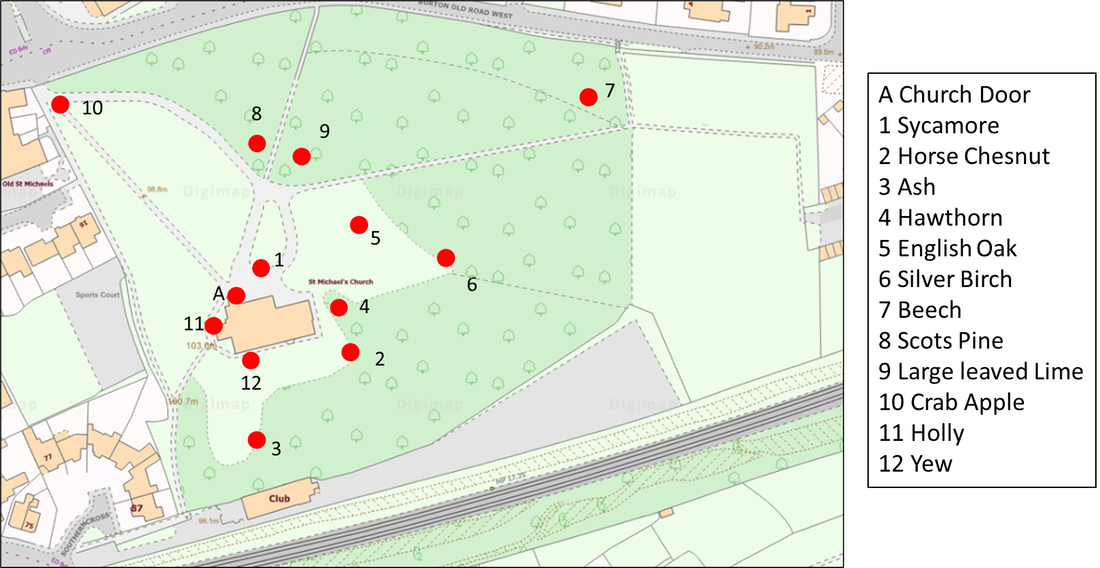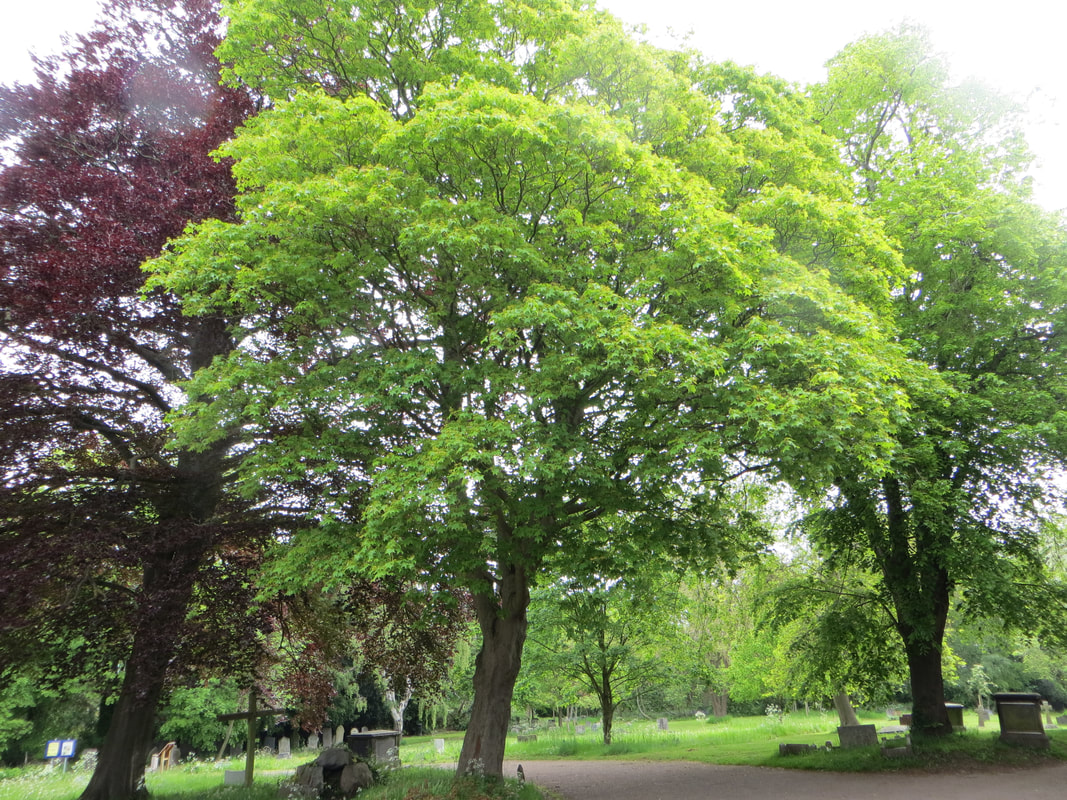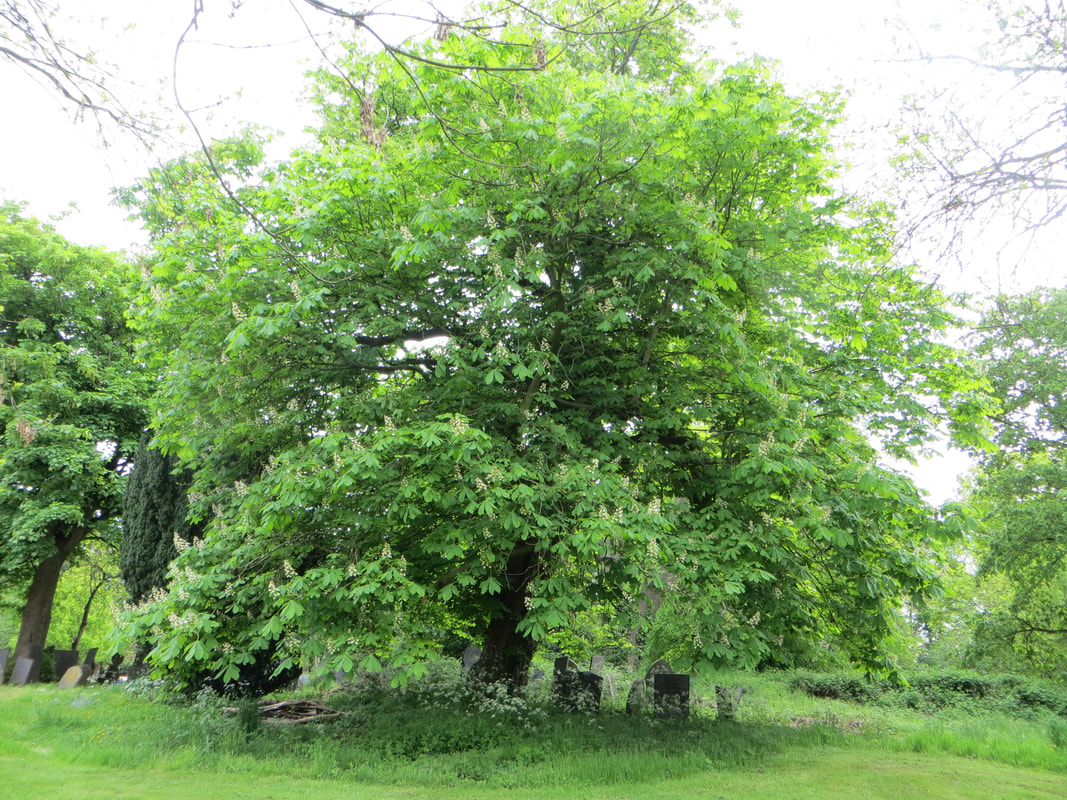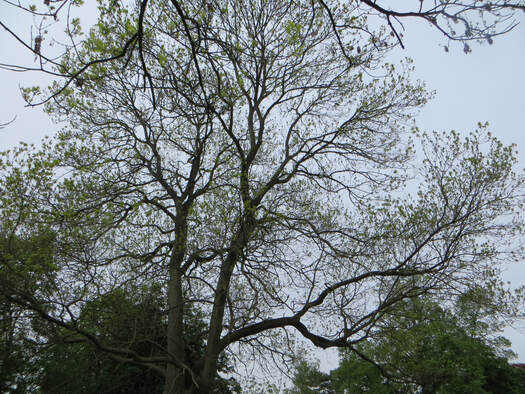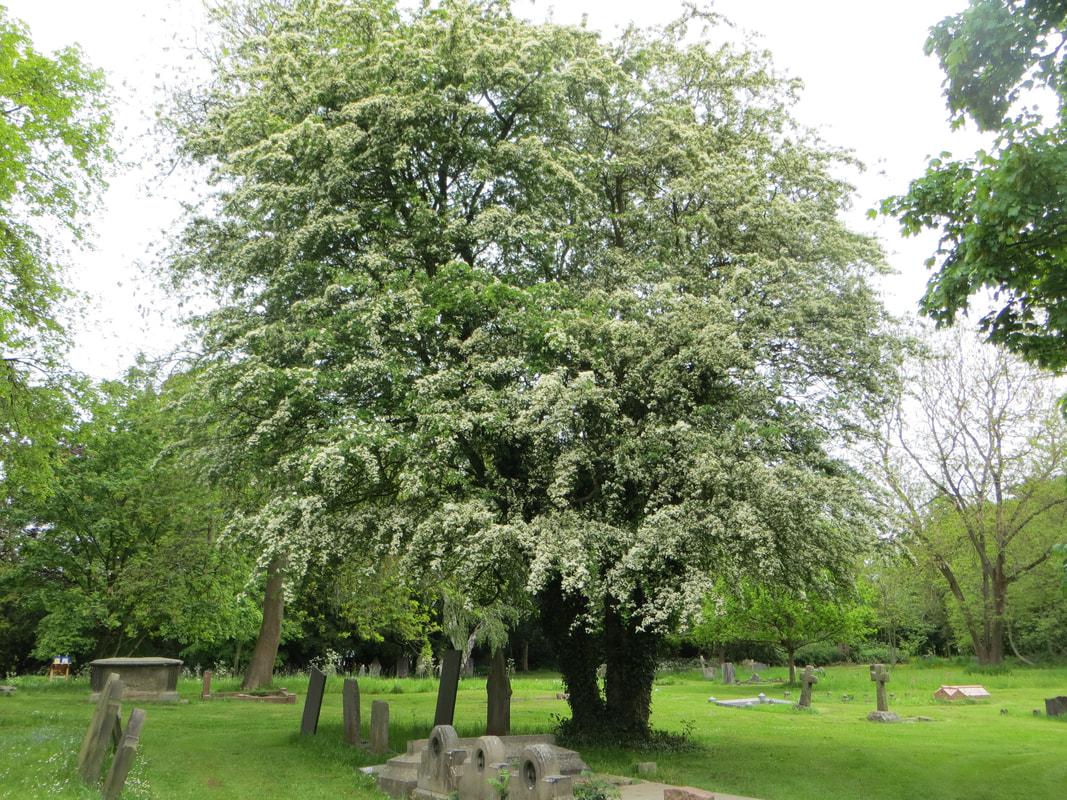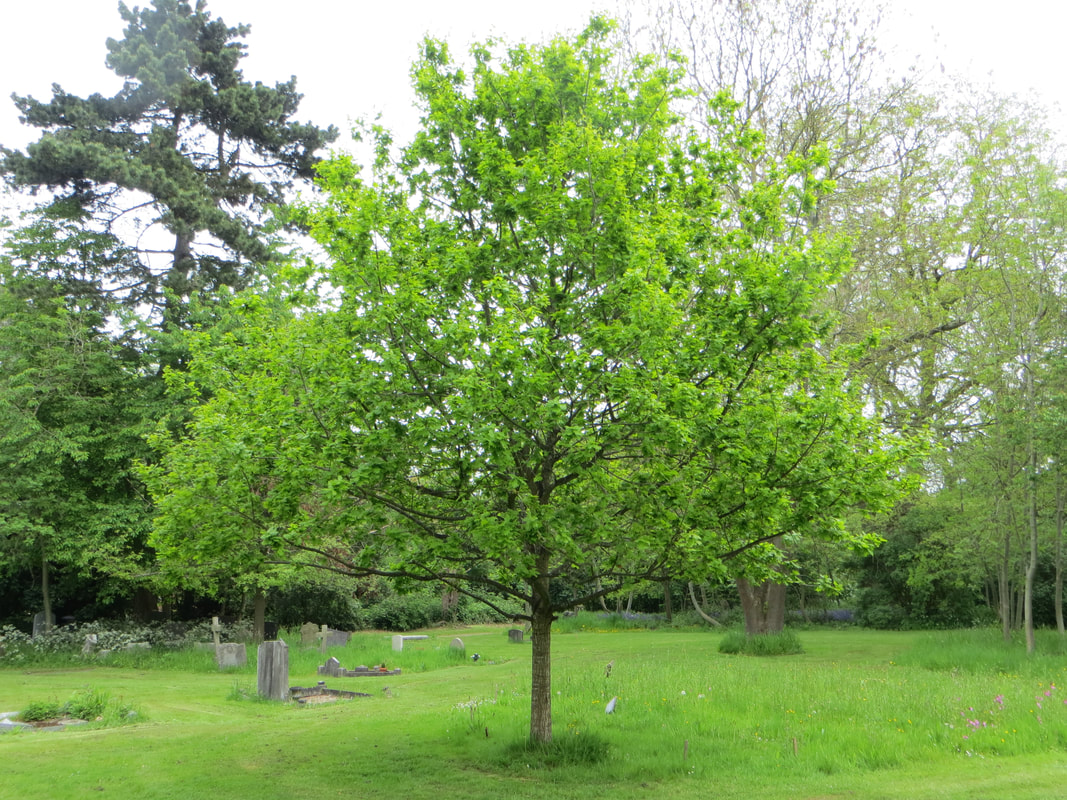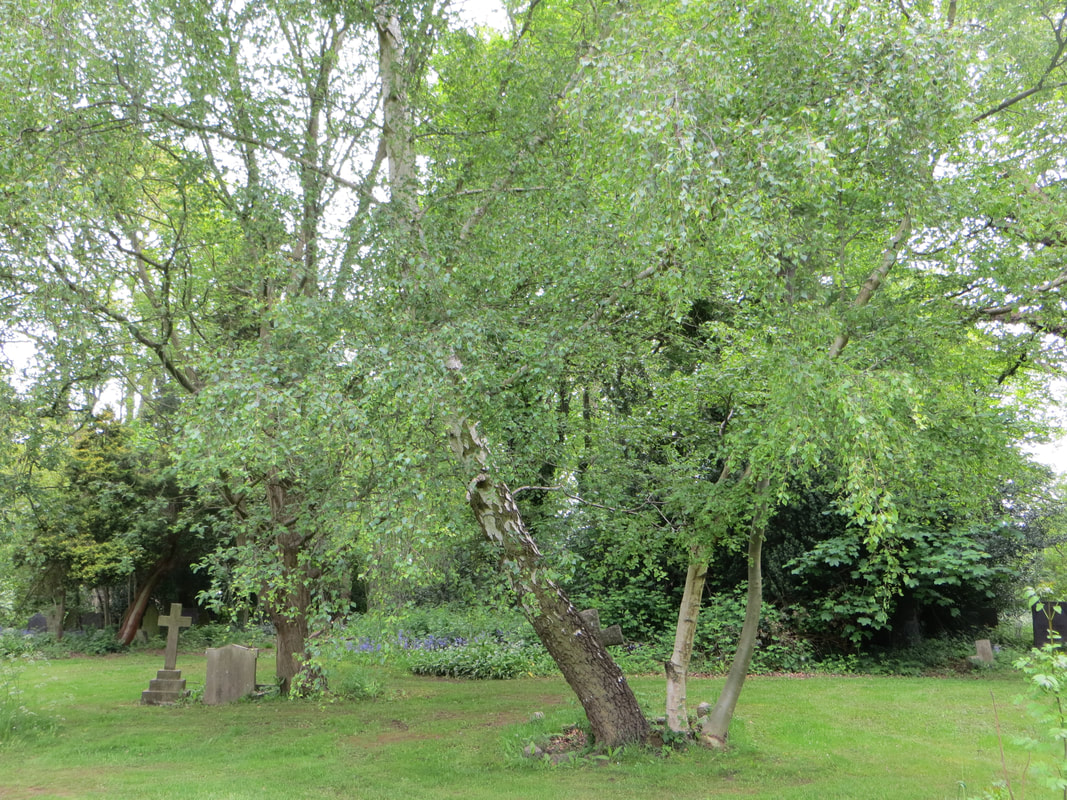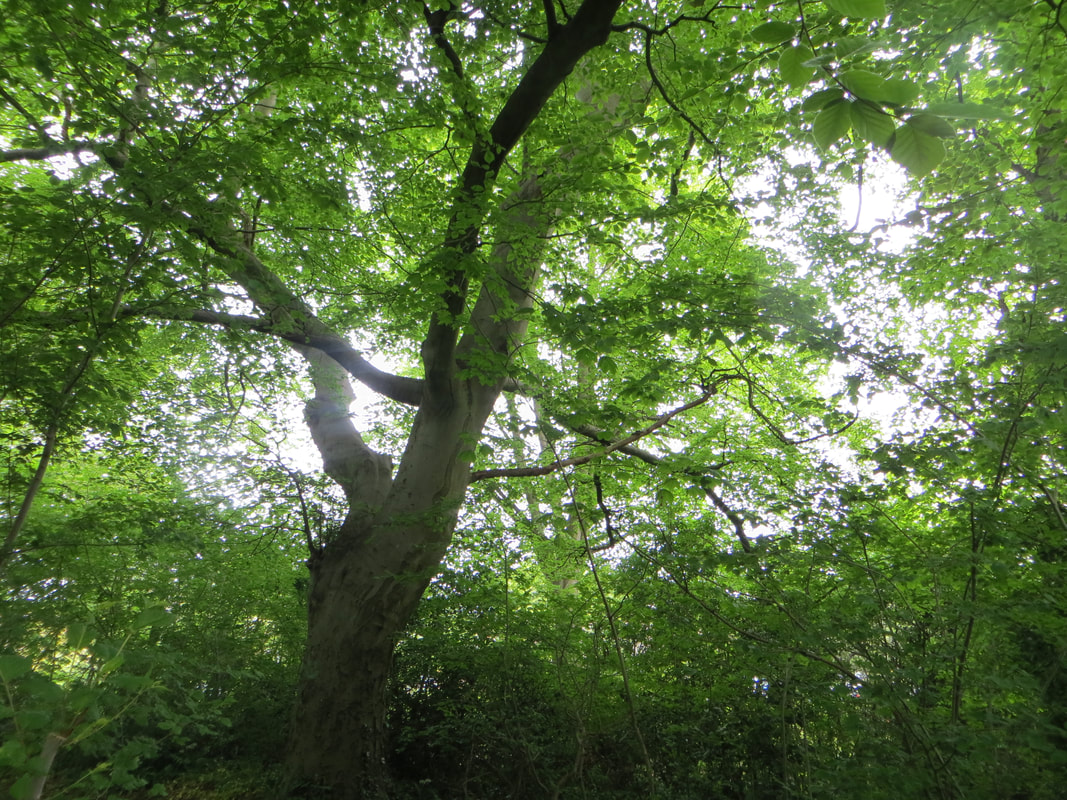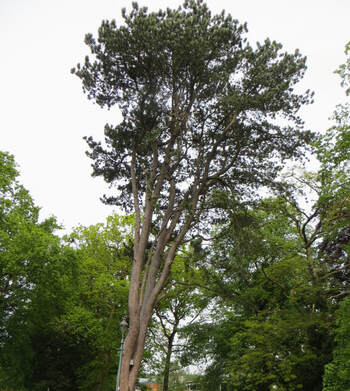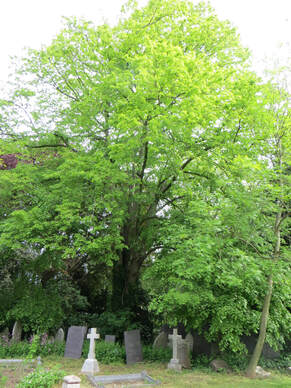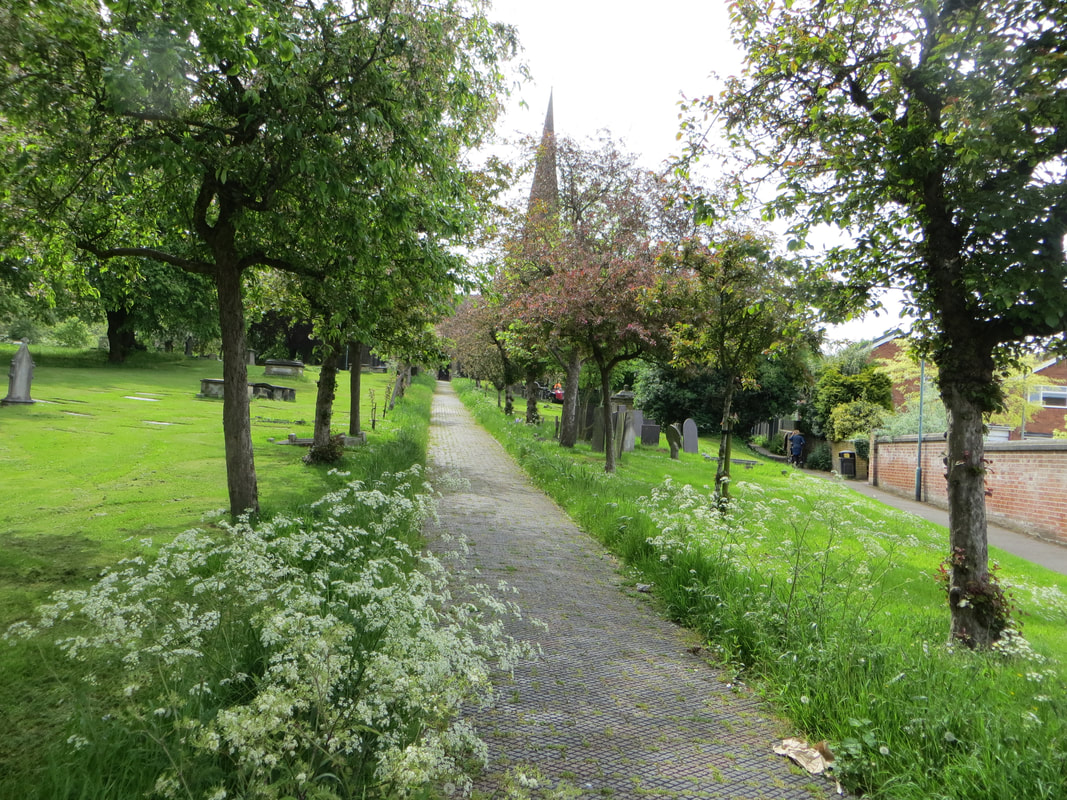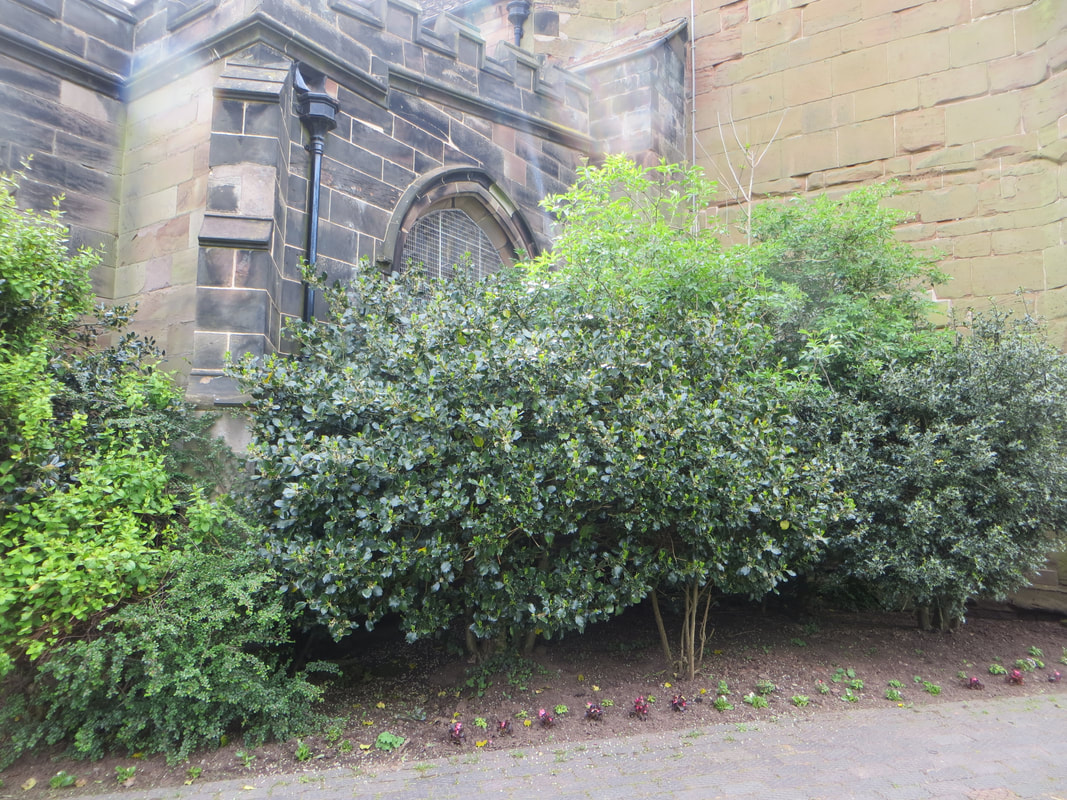A VIRTUAL TOUR OF THE TREES IN ST. MICHAEL'S CHURCHYARD
There are 12 trees on the trail. To find the trees look at the map and follow the directions to each tree. There is also a small amount of information for each tree. The trail begins at the Church Door facing the Crab Tree avenue. It may be followed on the map below, or through the directions given in the text.
|
Directions to Tree 1:.
Stand facing the Crab Apple Avenue. Turn 90 degrees to your right. Walk for 15 yards to the large tree in front of you. This is a Sycamore Tree. Introduced by the Romans, Sycamore has lovely helicopter seeds and provides food for wildlife. Sycamore Tree. Latin name: Acer pseudoplatanus Leaves: They are palmate and have 5 lobes. Flowers: These are small, green-yellow and hang in spikes. Twigs Pink-brown, hairless, they have green, egg-shaped, pointed buds. Bud scale tips are brown. Fruit: They develop from the female flowers and turn into winged fruits. |
Directions to Tree 2.
Go to the centre of the East Window at the opposite end from the Church Tower. Walk straight on for 20 yards, passing 3 large white tombs. Turn your body half left and walk for 20 yards. This is a Horse Chestnut Tree. Horse Chestnut gives nectar for bees and it has shiny brown conkers in the Autumn. Horse Chestnut Tree. Latin name: Aesculus hippocastanum. Leaves are palmate with 5-7 pointed, toothed leaflets spreading from a central stem. Flowers come in May. They have 4-5 white fringed petals with a pink flush at the base. Twigs are hairless and stout. Buds are oval, dark red, shiny and sticky. Fruit develops from the flowers and grows into a glossy red-brown conker inside a spiky green husk. |
|
Directions to Tree 3.
Turn round so you are facing the grassed area. Walk straight on for 10 yards, then turn slightly left and walk for 25 yards to a very large tree. This is an Ash tree. A much-loved tree which has recently suffered from Ash Dieback disease. |
Directions to Tree 4.
Walk back to the 3 large white tombs, then return to the centre of the East Window. Stand with the window behind you and look at the tree in front of you. This is a Hawthorn Tree. Its white Spring flowers are called May and they turn into shiny red berries in the Autumn. |
|
Ash Tree. Latin name: Fraxinus excelsior. Leaves have 3-6 opposite pairs of oval leaflets, 40 cm. long. Flowers are purple and grow in spiked clusters at the tips of twigs. Twigs are smooth and have black buds growing opposite each other. Fruits, known as Ash Keys, are seen in Summer and Autumn and are ringed. Directions to Tree 5.
Stand on the other side of the Hawthorn tree, with the tree behind you. Turn your body half-left and then walk for 22 yards to the tree that is in the centre of the large grassed area. This is an English Oak Tree. This tree supports more life than any other tree species and its acorn fruits are loved by animals. English Oak Tree. Latin name: Quercus robur. Leaves: 10 cm. long, with 4-5 deep lobes. The leaves have almost no stem and grow in bunches. Flowers: Long yellow hanging catkins which distribute pollen into the air. Twigs have rounded buds which grow in clusters. Fruits: Called acorns, the fruits are 2-2.5 cm. long. They grow on long stalks and in cups. |
Hawthorn Tree. Latin name: Crataegus monogyna. Leaves are 6 cm. long with toothed lobes cutting at least half way to the middle of the leaf. Flowers are highly scented, white or pink, with 5 petals, growing in flat-topped clusters. Twigs are slender, brown and covered in thorns. Fruits: Once flowers are pollinated by insects, deep red fruits develop. They are called haws. Directions to Tree 6.
Stand with the Oak tree and the Church behind you. Look right and walk to the tree that has a thick round stake by its trunk. Stand to the right of this tree and walk forward for about 17 yards to 3 tree trunks by a grave, with a stone cross. This is a Silver Birch Tree. This tree has beautiful silver-white bark and dainty catkins and leaves in the Spring. Silver Birch Tree. Latin name: Betula pendula. Leaves are light green, small and triangular-shaped, with a smooth edge. Flowers are called catkins. The male ones are long and hang in groups. They are like lambs’ tails. Twigs are smooth with small dark warts. They are rough to the touch in winter. Fruit: Short female catkins thicken and change to dark crimson fruits as they disperse the seeds. |
|
Beech Tree. Latin name: Fagus sylvatica. Leaves: Light, then dark green, 4-9 cm long, stalked, oval, pointed at the tip and with a wavy edge. Flowers. Male catkins hang from long stalks at twig ends. Females grow in pairs within a cup. Twigs: Leaf buds are pointed not pressed against twigs. They often keep leaves through winter. Fruit: A cup forms and encloses one or two nuts known as beech mast. |
Scots Pine Tree. Latin name: Pinus sylvestris Leaves: Needle-like leaves are blue-green, slightly twisted and grow in pairs on short side shoots. Flowers: Males are yellow at shoot bases; females are small, red-purple, globular and at shoot tips. Twigs: They are green-brown and hairless. Fruit: Females go green, develop into grey-brown cones with a raised bump at the scale’s centre. |
|
Directions to Tree 9.
The next tree is very near to the Scots Pine tree. Turn round and walk to the large mature tree on your left. This is the Large-leaved Lime Tree. The large-leaved lime is a handsome tree that is a rich home for wildlife. Its fruits are sticky. Lime Tree. Latin name: Tilia europaea Leaves: Heart-shaped, a pointed tip, soft hairs and hairy stalks. 6-12 cm long; droop in hot weather. Flowers: Green-yellow, with 5 petals. They hang in clusters of 4 to 10. Fruit: Once pollinated by insects flowers develop into round to oval smooth fruits and pointed tips Twigs: Grey. Not very hairy. Red buds are longer than 4 mm. They only have 2 to 3 scales. |
Directions to Tree 10.
Go to the main Church Drive. Walk down to the end of the Drive and look up to the Church. Here you will see an avenue of trees. These are Crab Apple Trees. The Avenue is very old and there have been trees here since before the year 1800. Crab apples have gorgeous flowers in Spring. The Autumn fruits are made into crab apple jelly. Crab Apple. Latin Family Name: Malus Leaves: Pointed buds; short stalks; downy hair on leaf tips; long glossy oval leaves; rounded teeth. Flowers: The crab apple has beautiful clusters of sweetly scented pinkish white flowers in Spring. Fruit: Our Crab Apples are a variety called Wisley Crab. They have large red apples in Autumn. Twigs: Twigs are gnarled and twisted giving a spiny appearance. They are often covered in lichens. |
|
Directions to Tree 11.
Walk up the Crab Apple Avenue to the Church door. Turn right. Here, on the left of the path, you will see a Holly Tree. Holly is a well-loved evergreen tree. It has small white flowers and bright red berries at Christmas. Holly Tree. Latin name: Ilex aquifolium. Leaves: Dark green, glossy, oval; young plants’ leaves spiky, older ones and higher leaves smooth. Flowers: White, with 4 petals. They bloom between Spring and the very beginning of Summer. Fruit: Once pollinated, female flowers develop into scarlet berries and stay through Winter. Twigs: Lots of leaves grow on either side of the twigs all year round. |
Directions to Tree 12.
Continue walking on for a few more yards and then turn left just after the Church Tower; then walk to the large Evergreen tree growing in the grass in front of you. This is a Yew Tree. Yew trees can often be seen growing in Churchyards. They can live for 5,000 years. Common Yew Tree. Latin name: Taxus baccata. Leaves, called needles, are straight and small with a pointed tip. They are dark green above, green below, growing in 2 rows on the sides of the Twigs. Male & female Flowers grow on separate trees, males white-yellow, globular; young females bud-like, scaly, green and brown; like acorns when older. Fruit: seeds not in cones but in a berry-like structure called an aril which is open at the tip. |
You have now reached the end of the Churchyard Tree Trail. We hope you enjoyed finding and learning about the trees.

